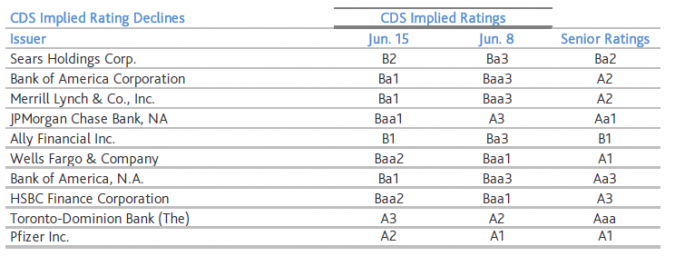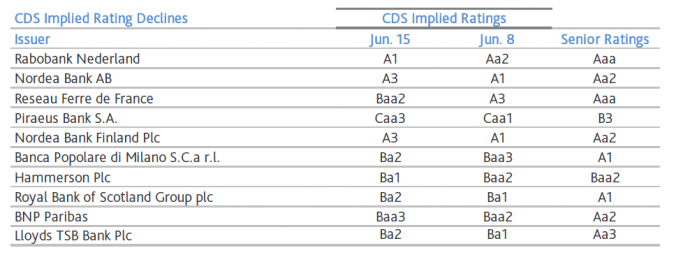Everybody hates rating agencies. They missed Enron (balance sheet fraud), the sub-prime crisis (using models provided by banks) and sovereign debt crisis (concealed by foreign currency swaps). They have been wrong – so what? Stock market analysts are wrong all the time, and investors still read their worthless reports. And what would you expect from a stock recommendation if you knew it was paid for by the company the report is about?
(People – you really need to switch off that Consumer News and Business Channel and put on your thinking caps.)
Anyway. I came across this Weekly Market Outlook from Moody’s Analytics. They do something remarkable. They compare their own ratings with the rating implied by CDS (credit default swaps). Usually the rating agencies are a little bit behind the curve, so the CDS can give more of a “real-time” view of where the rating should be.
In this week’s report we find the following table:
Source: Weekly Market Outlook, June 16, 2011, Moody’s Analytics, page 27
Look at Bank of America and Merrill Lynch (now, of course, owned by BoA). Their implied rating is junk! JPMorgan Chase, Well Fargo and HSBC Finance Corp are not far behind in the BBB category.
I know, there is some rating uplift from assumed government support, but still – who wants to do business with a junk-rated financial institution with a leveraged balance sheet and funky accounting principles (FAS 157)?
 “Come and I’ll take you for a ride. I am a junk-rated bank.”
“Come and I’ll take you for a ride. I am a junk-rated bank.”
Over in Europe, it probably doesn’t come as a shock that Rabobank actually isn’t really AAA. The ratings of BPM, RBS and Lloyds shouldn’t be part of the investment-grade club. And BNP-Paribas, merely the world’s largest bank by assets, is one step away from an implied junk level:
Source: Weekly Market Outlook, June 16, 2011, Moody’s Analytics, page 28
With industrial companies, rumors of bankruptcy often become self-fulfilling prophecies. Suppliers, anxious to be left with outstanding receivables, begin asking for cash on delivery. This further aggravates the liquidity situation of the already troubled company. Banks usually shy away from extending credit (or offering new credit lines). And so the company goes bankrupt.
Large banks have the adorable habit of bankrupting entire nations (Ireland was financially healthy before it was forced to bail-out its banks). In the last round (2008/2009), governments still had financial leeway to bail-out their banking sectors. Three years later, this is not the case.
The last card up the banks’ sleeve remains mutually assured destruction: if you (governments / tax payers) let us go down, everybody goes down. Banks bail-out governments, governments bail-out banks. Until the rope slips:



